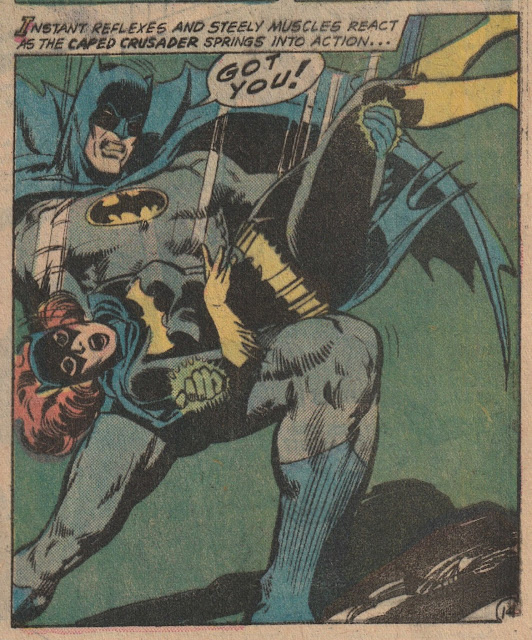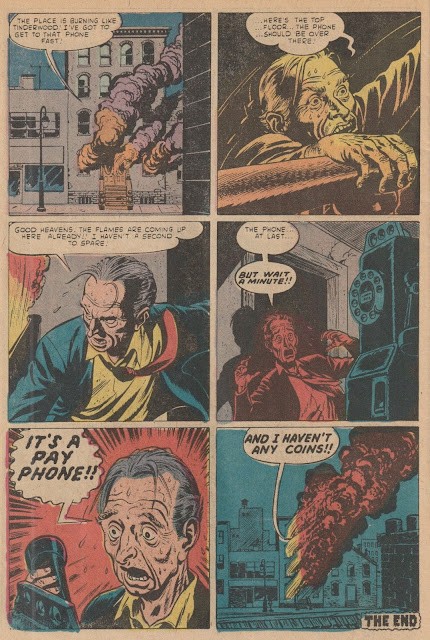SUPER-TEAM FAMILY #3 - Everything but the Kitchen Sink!
I swear I have a whole bunch of Marvel's to review coming up, but I was in the mood to read some of these DC's that I, for some reason, didn't even see when I was a kid. Case in point: To keep pounding home their meal ticket's vast array of supporting characters, DC put out these 68 page, multi-story comics. And just to make sure it sold, they put a Gorilla on the cover!
(SUPER-TEAM FAMILY #3 - Cover Dated Feb/Mar 1976 - on Newsstands November 25th, 1975 - cover art signed by Frank Brunner)
There's a little bit to that.
The legend has it that when DC put a gorilla on the cover of Strange Adventures #8 in May of 1951, they saw such a noticeable sales surge that they started to regularly put gorilla's on the covers of various issues. Editor-in-Chief Julius Schwartz had to put a 'one per month' rule on it to make sure they didn't over do it!
In The Comics Journal #214, long time DC artist Sheldon Moldoff said: "It was a question of trying to find something that sold, and if one issue came out and it happened to sell, then immediately they would follow that type of story. Now, it didn't neccessarily follow through that they were going to sell. Now, I know Jack Schiff, when he was the editor of Batman, he followed sales very well. When he found that a gorilla on covers sold, then you could be damn sure that in an issue or two you're going to have another gorilla story."
Sounds plausible. One day, I may... research it...
(SUPER-TEAM FAMILY #3 - Cover Dated Feb/Mar 1976 - on Newsstands November 25th, 1975 - art by Ric Estrada with inks by Wally Wood)
And hey, why not put one in bed with Hawkman's wife?
The opening story, 'The End of the World' features Hawkman becoming a gorilla and going on a crime spree. Written by Steve Skeates, who got his start as Stan Lee's assistant (it didn't go well), before writing at Tower Comics with legendary artist Wally Wood (who inks this story). Drawn by longtime artist Ric Estrada, it's an interesting pairing of talents.
(SUPER-TEAM FAMILY #3 - Cover Dated Feb/Mar 1976 - on Newsstands November 25th, 1975 - art by Ric Estrada with inks by Wally Wood)
As a fan of Romance Comics, you can certainly see the influence here. Despite waking up with a gorilla in her bed, who turns out to be her transformed husband, Hawkgirl makes sure she gets her outfit right before heading out! Estrada has a very Ditko influence here, I suppose brought out by the inks of Wally Wood. In fact, I wonder how much of this Wood actually just drew himself.
(SUPER-TEAM FAMILY #3 - Cover Dated Feb/Mar 1976 - on Newsstands November 25th, 1975 - art by Ric Estrada with inks by Wally Wood)
I mean... how much influence over this whole story did Wood have? This sequence could be right out of a Sally Forth story! Except... ya know... she has clothes on...
(SUPER-TEAM FAMILY #3 - Cover Dated Feb/Mar 1976 - on Newsstands November 25th, 1975 - art by Mike Grell)
I don't remember doing it, but I sent away for this and cherished it so much I still have the original. Man is it beat up! But one of my earliest comics I remember loving was Superboy #195 (Legion back-up story with the first Wildfire, then as Erg-1) and Superboy #198 (with a FULL Legion issue with Superboy vs the Fatal Five), followed by a few Grell issues. I thought the Legion was very modern looking and exciting compared to some of the boring old DC heroes.
(SUPER-TEAM FAMILY #3 - Cover Dated Feb/Mar 1976 - on Newsstands November 25th, 1975 - art by Ramona Fradon)
Speaking of boring old Superheroes (aw, I like these guys - I do!), the next story teams up Aquaman and Green Arrow, as their villains come up with a great idea of switching the way they do crime - in order to confound the water bound Aquaman and the land lover Green Arrow. I'm a big fan of cartoony art, when it's done well, and Ramona Fradon is one of my favorites of this era (this story is reprinted from Adventure Comics #267, December 1959).
(SUPER-TEAM FAMILY #3 - Cover Dated Feb/Mar 1976 - on Newsstands November 25th, 1975 - art by Ramona Fradon)
EC Comics may have been run out of business with their horror and violence, but this was still an era when the bad guys could pull out shotguns and blow your headlights out! CAR headlights that is (or in this case Truck headlights). Hmmm... a truck? Aquaman strikes me as more of a sportscar type of guy, but... he IS outdoorsy, so I guess it makes sense.
(SUPER-TEAM FAMILY #3 - Cover Dated Feb/Mar 1976 - on Newsstands November 25th, 1975 - art by Ramona Fradon)
And sure, just use the swordfish to pin these guys against the wall...
And you have to love the bubble helmet he has to wear. I think they should've stuck with that look. It gives him a unique appeal, that no other hero has... I mean... What mainstream hero wears a Bubble Helmet? That's actually pretty cool.
(SUPER-TEAM FAMILY #3 - Cover Dated Feb/Mar 1976 - on Newsstands November 25th, 1975 - art by Lee Elias)
Lee Elias, who I know more from his work in the 50's, is the artist on the Green Arrow side of the story and so we get... Godzilla? I have to admit, when I started reading this, I wasn't expecting Green Arrow and Speedy to be underwater, shooting arrows at a fire-breathing Godzilla knock off.
So there's that!
(SUPER-TEAM FAMILY #3 - Cover Dated Feb/Mar 1976 - on Newsstands November 25th, 1975 - art by Neal Adams)
Did we forget to include anyone in the Super-Team Family? We sure did!
So here's Batman, Superman, Batgirl, Supergirl, Robin and even Jimmy Olsen, who isn't super at all!
Reprinted form World's Finest Comics #176 (June 1968), it was written by DC workhorse Cary Bates and drawn by Neal Adams!
It's about an alien who's on the run from his planet where they're trying to kill him and a fellow alien law enforcement agent who says he's a criminal. For some reason, neither the World's Greatest Detective or the World's Greatest Alien can determine which one is lying, so they each take a side against the other!
(SUPER-TEAM FAMILY #3 - Cover Dated Feb/Mar 1976 - on Newsstands November 25th, 1975 - art by Neal Adams)
The female characters seem to get a rough go of it here...
(SUPER-TEAM FAMILY #3 - Cover Dated Feb/Mar 1976 - on Newsstands November 25th, 1975 - art by Neal Adams)
But Superman gets the most crushing blow of all. Is it me, or does Batman just always seem to take such great delight when he finds a way to one up old Supes?
(SUPER-TEAM FAMILY #3 - Cover Dated Feb/Mar 1976 - on Newsstands November 25th, 1975 - art by Neal Adams)
Cary Bates was probably one of the more 'hip' guys at DC Comics during this period - which isn't saying much. Compared to Ted Knight, Mary Tyler Moore seemed like a swingin' chick.
Nevertheless, Bates could provide some modern humor into things...
(SUPER-TEAM FAMILY #3 - Cover Dated Feb/Mar 1976 - on Newsstands November 25th, 1975 - art by Neal Adams)
Overall, a pretty decent issue, with some good art. See! I should've just had fun and read some more DC's when I was a kid!




















































